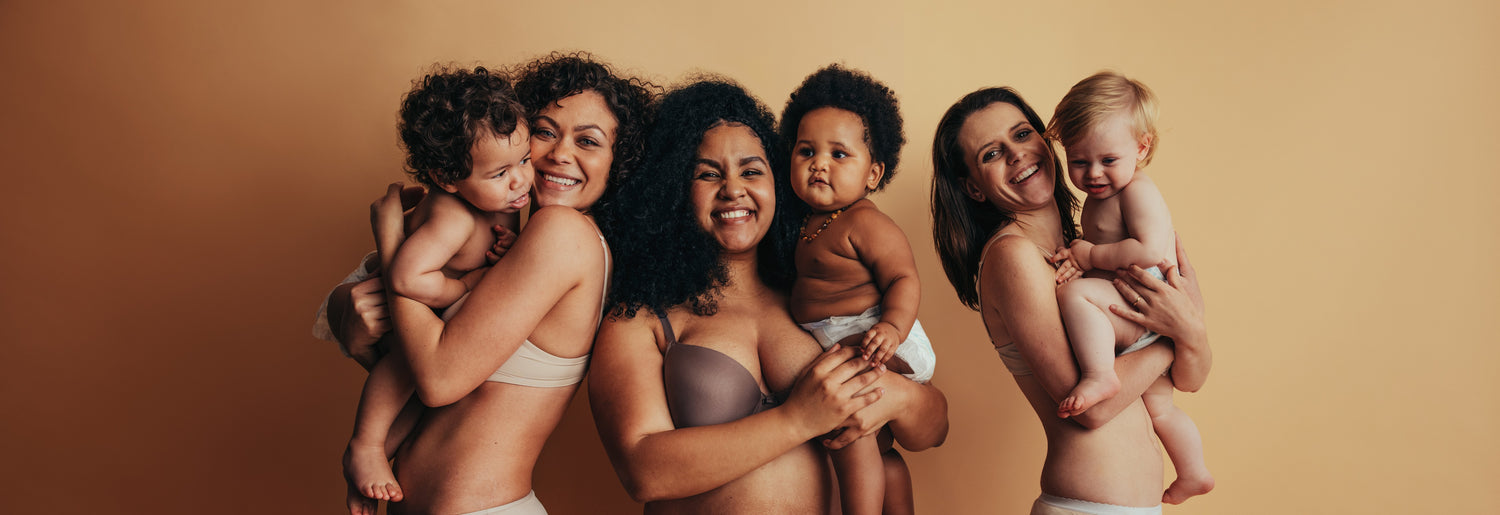While there is a ton of information on the internet about “What to expect when you are expecting”, there is a lot less information out there on the postpartum period. As a result, many new moms remain surprised by the recovery process their own body needs to go through after childbirth. Bringing a baby into this world is most likely one off the most strenuous activities your body will ever go through, so it’s only normal that it will take time to heal.
As a new mom you want to be there 24/7 for your new baby. But at the same time, it’s important that you take care of your own body. Full recovery from an uncomplicated vaginal delivery will take up to 6 weeks. Recovery from a C-section will take even longer. During this recovery period your body re-balances its hormones and sheds excess weight as your uterus shrinks back to its pre-pregnancy size.
One of the most important ways you can assist your body in its recovery – besides getting enough rest and eating healthy – is by wearing a postpartum abdominal binder. Chances are you were given a binder at the hospital in case you had a C-section. If not, you probably browsed the Internet and may have gotten a bit overwhelmed by the innumerable types of products that are on offer: belly binders, belly wraps, abdominal binders, support wraps, postpartum girdles, the list goes on forever. As varied as the look, feel and cost of many of these garments, are the widely diverse and wonderful claims made by their manufacturers. Who would not want their pre-pregnancy body back in 3 weeks and pay $100 for it?
Unfortunately, there are as many myths as facts going around when it comes to postpartum binders and there is no lack of snake oil salesmen out there. So, with that in mind I decided to list some myths and facts about what is one of our most important products at AltroCare.
Fact: Wearing an abdominal binder after C-section reduces pain.
During a C-section the surgeon cuts into layers of tissue and muscle in a sensitive area that can lead to infections, blood clots or injury to your bowel or bladder. Like with most abdominal surgeries, compressing your abdomen after the procedure will help reduce swelling and increase blood flow. That means a faster recovery and less pain. A clinical trial done in 2015 and published in “Obstetrics & Gynecology” states that patients report “significantly lower” post-operative pain scores when they wear an abdominal binder after C-section.
Fact: 60 percent of all women are affected with diastasis recti after childbirth
Diastasis recti is the scientific term for “mummy tummy”. It is what happens when the connective tissue between your abdominal muscles stretches during pregnancy. The symptoms, which are experienced by over 60% of new moms, can vary from just cosmetic (the famous postpartum pooch) to debilitating (severe lower back pain and incontinence). The bad news is that nobody really knows what women can do to get rid of diastasis recti, so prevention is key. That means wearing an abdominal binder immediately after giving birth and abiding by a strict regimen of postpartum exercises, even for moms who did not have a C-section.
Myth: Wearing a belly band or binder will help you lose weight immediately
We hate to admit it, but contrary to what you may have read on the Internet, nothing can replace exercise. As your body sheds fluids after childbirth you will automatically lose weight, whether you wear an abdominal binder or not. Breastfeeding may also help you to lose weight, as your body converts body fat into nourishment for your baby. In order to strengthen your abdominal muscles however nothing can replace exercise. Start slowly with low-impact activity, such as walking and gradually ease into moderate-intensity aerobic activity. As for all those sales pitches you’ve seen for expensive belly wrappers that will restore your pre-pregnancy body in the blink of an eye without effort? Pure fiction!
Myth: One size fits all when it comes to abdominal binders
Merchants don’t like to hold many different sizes of their products in stock. And one way to do this is by selling “universal” products that supposedly are “one size fits all”. In reality however, our bodies come in many sizes and wearing a badly fitting binder will not only be very uncomfortable, it will also limit the benefit you get from it. Check out our previous blog article on how to measure for the correct size binder. Measure you body immediately after giving birth to select the correct size and choose a binder that is hook receptive over the entire length of the elastic material (no hooks!) so you can adjust the pressure gradually as your body returns to its pre-pregnancy size.
Myth: The more expensive abdominal binder is the best
A search on Google Shopping for “postpartum abdominal binder” returns over six pages of different garments with prices ranging from as low as $8 for a used product to over $100 for some of the most expensive binders that look more like your grandmother’s girdle. Warning: most of the bells and whistles you see on expensive belly wraps have little or no therapeutic value and may even be counterproductive. Avoid binders that have hooks (not easy to adjust), are made in one panel (tend to roll up) or look like a corset (tend to be uncomfortable). Also avoid buying used products as the quality of the elastic will degrade if the binder is washed at high temperatures or with chlorine bleach.
Our AltroCare binders are made of premium polyester-spandex elastic and feel extremely soft against your skin, so you can wear them under your clothes. They are knit in 3 panels, which helps the binder adjust to your body shape and prevents rolling up. They are hook receptive over the entire length of the binder, so they can be adjusted easily.
As a new mom you want to be there 24/7 for your new baby. But at the same time, it’s important that you take care of your own body. Full recovery from an uncomplicated vaginal delivery will take up to 6 weeks. Recovery from a C-section will take even longer. During this recovery period your body re-balances its hormones and sheds excess weight as your uterus shrinks back to its pre-pregnancy size.
One of the most important ways you can assist your body in its recovery – besides getting enough rest and eating healthy – is by wearing a postpartum abdominal binder. Chances are you were given a binder at the hospital in case you had a C-section. If not, you probably browsed the Internet and may have gotten a bit overwhelmed by the innumerable types of products that are on offer: belly binders, belly wraps, abdominal binders, support wraps, postpartum girdles, the list goes on forever. As varied as the look, feel and cost of many of these garments, are the widely diverse and wonderful claims made by their manufacturers. Who would not want their pre-pregnancy body back in 3 weeks and pay $100 for it?
Unfortunately, there are as many myths as facts going around when it comes to postpartum binders and there is no lack of snake oil salesmen out there. So, with that in mind I decided to list some myths and facts about what is one of our most important products at AltroCare.
Fact: Wearing an abdominal binder after C-section reduces pain.
During a C-section the surgeon cuts into layers of tissue and muscle in a sensitive area that can lead to infections, blood clots or injury to your bowel or bladder. Like with most abdominal surgeries, compressing your abdomen after the procedure will help reduce swelling and increase blood flow. That means a faster recovery and less pain. A clinical trial done in 2015 and published in “Obstetrics & Gynecology” states that patients report “significantly lower” post-operative pain scores when they wear an abdominal binder after C-section.
Fact: 60 percent of all women are affected with diastasis recti after childbirth
Diastasis recti is the scientific term for “mummy tummy”. It is what happens when the connective tissue between your abdominal muscles stretches during pregnancy. The symptoms, which are experienced by over 60% of new moms, can vary from just cosmetic (the famous postpartum pooch) to debilitating (severe lower back pain and incontinence). The bad news is that nobody really knows what women can do to get rid of diastasis recti, so prevention is key. That means wearing an abdominal binder immediately after giving birth and abiding by a strict regimen of postpartum exercises, even for moms who did not have a C-section.
Myth: Wearing a belly band or binder will help you lose weight immediately
We hate to admit it, but contrary to what you may have read on the Internet, nothing can replace exercise. As your body sheds fluids after childbirth you will automatically lose weight, whether you wear an abdominal binder or not. Breastfeeding may also help you to lose weight, as your body converts body fat into nourishment for your baby. In order to strengthen your abdominal muscles however nothing can replace exercise. Start slowly with low-impact activity, such as walking and gradually ease into moderate-intensity aerobic activity. As for all those sales pitches you’ve seen for expensive belly wrappers that will restore your pre-pregnancy body in the blink of an eye without effort? Pure fiction!
Myth: One size fits all when it comes to abdominal binders
Merchants don’t like to hold many different sizes of their products in stock. And one way to do this is by selling “universal” products that supposedly are “one size fits all”. In reality however, our bodies come in many sizes and wearing a badly fitting binder will not only be very uncomfortable, it will also limit the benefit you get from it. Check out our previous blog article on how to measure for the correct size binder. Measure you body immediately after giving birth to select the correct size and choose a binder that is hook receptive over the entire length of the elastic material (no hooks!) so you can adjust the pressure gradually as your body returns to its pre-pregnancy size.
Myth: The more expensive abdominal binder is the best
A search on Google Shopping for “postpartum abdominal binder” returns over six pages of different garments with prices ranging from as low as $8 for a used product to over $100 for some of the most expensive binders that look more like your grandmother’s girdle. Warning: most of the bells and whistles you see on expensive belly wraps have little or no therapeutic value and may even be counterproductive. Avoid binders that have hooks (not easy to adjust), are made in one panel (tend to roll up) or look like a corset (tend to be uncomfortable). Also avoid buying used products as the quality of the elastic will degrade if the binder is washed at high temperatures or with chlorine bleach.
Our AltroCare binders are made of premium polyester-spandex elastic and feel extremely soft against your skin, so you can wear them under your clothes. They are knit in 3 panels, which helps the binder adjust to your body shape and prevents rolling up. They are hook receptive over the entire length of the binder, so they can be adjusted easily.



